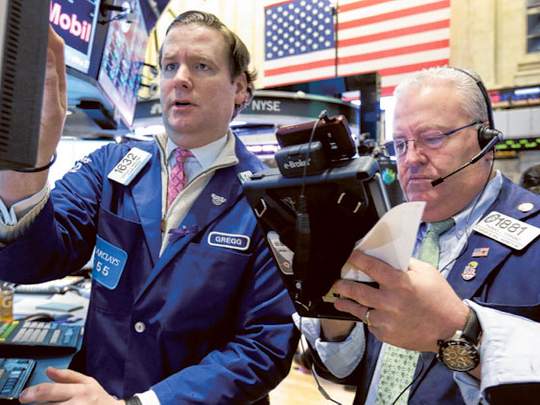
New York: The US stock market is no stranger to strong performances in January, only to see the lofty gains early in the year transition into months of grinding action that goes nowhere.
That’s what happened in 2011 and 2012, and some analysts think 2013 could follow the same routine. Markets are up this year in the face of Washington’s debates over fiscal policy but a looming deadline on spending reductions could test the gains.
“This is almost a carbon copy of last year,” said Alan Lancz, president of Alan B. Lancz & Associates Inc in Toledo, Ohio. The mentality is “ride the wave as far as you can and try not to be the last one off,” Lancz said.
Major indexes recently crossed psychologically important milestones — 1,500 for the S&P 500 and 14,000 for the Dow industrials. The S&P is at its highest level in five years, while the Nasdaq finished on Friday at its highest close since November 2000, the tail end of the internet bubble.
The current levels are more significant than Wall Street’s usual fixation on round numbers. This is only the second time the Dow has reached 14,000, and the third time the S&P has hit 1,500.
Overall bullishness
That could leave the market churning as investors test whether there’s enough support to reach new highs or if a pullback is needed. The sharp gains and overall bullishness on Wall Street leave stocks vulnerable to sudden shocks, such as a flare-up of the financial crisis in the Eurozone, which momentarily sidetracked the market earlier this week.
One significant hurdle is the automatic federal spending cuts that will go into effect as of March. So far, the equity market has largely ignored the back-and-forth related to delaying the so-called sequester that would trigger $85 billion (Dh312 billion) in automatic spending cuts, which would hit the defence industry particularly hard.
If the cuts go ahead unchanged, that could slow economic growth this year due to the swiftness of the cuts, according to the Congressional Budget Office (CBO). While that’s not as dire as the immediate threat of default presented by a possible failure to raise the debt ceiling, it isn’t positive for markets.
“I don’t see any grand compromise coming, largely because the markets are so complacent,” said Greg Valliere, chief political strategist at Potomac Research Group in Washington.
With the economic calendar light next week, investors could start to focus more on the political jockeying. President Barack Obama’s State of the Union address on Tuesday may also provide some insight into how the talks may shape up.
Valliere put a 60 per cent chance on the sequester coming into effect next month while Washington scrambles to come up with a solution to alter it over the spring.
“They are way, way apart on a deal,” said Valliere.
Deal making
Markets may also be ignoring the political deal making because the spending cuts would go towards reducing the United States’ high debt level. The CBO report, which included the cuts as they are, forecast the budget deficit will drop below $1 trillion a year after four years above that level.
But analysts are worried about the broader implications of slower growth.
“Across-the-board cuts will really be more damaging than strategic cuts,” said Lancz. “If we go into recession, all cards are off the table.”
The economy already unexpectedly contracted in the fourth quarter of last year, but more recent data suggests subsequent revisions will show the economy did in fact grow, though at a weak pace.
The future path of monetary policy will be in focus next week as several members of the Federal Reserve are scheduled to speak on the economy and policy. The central bank is currently buying $85 billion worth of assets a month as it tries to bolster the economy.
A growing number of policy makers say the Fed should taper its bond-buying when the time is right rather than bring the stimulus to an abrupt end and investors will be looking for signs of what the central bank’s exit strategy may be.
The S&P 500 closed above 1,500 on Friday, though it likely faces resistance getting above 1,523.57, which would be its highest intraday level since November 2007.
Analysts say the index could ultimately make a run for the all-time high of 1,576.09.
Pullback
Jeff Kleintop, chief market strategist at LPL Financial in Boston, expects the market will see a pullback in the 5 per cent range, though that should present a better buying opportunity.
Kleintop suggests using the dips to buy stocks in sectors such as homebuilders and transportation.
“When you’re in a trading range, you want to buy what’s working.”
For now, analysts are taking the market’s sideways direction as a healthy move as it tries to establish a stronger base to push higher.
“To be stuck in a trading range for a period of time after having a jack-rabbit start to the year is probably a positive sign,” said Art Hogan, managing director of Lazard Capital Markets in New York.












